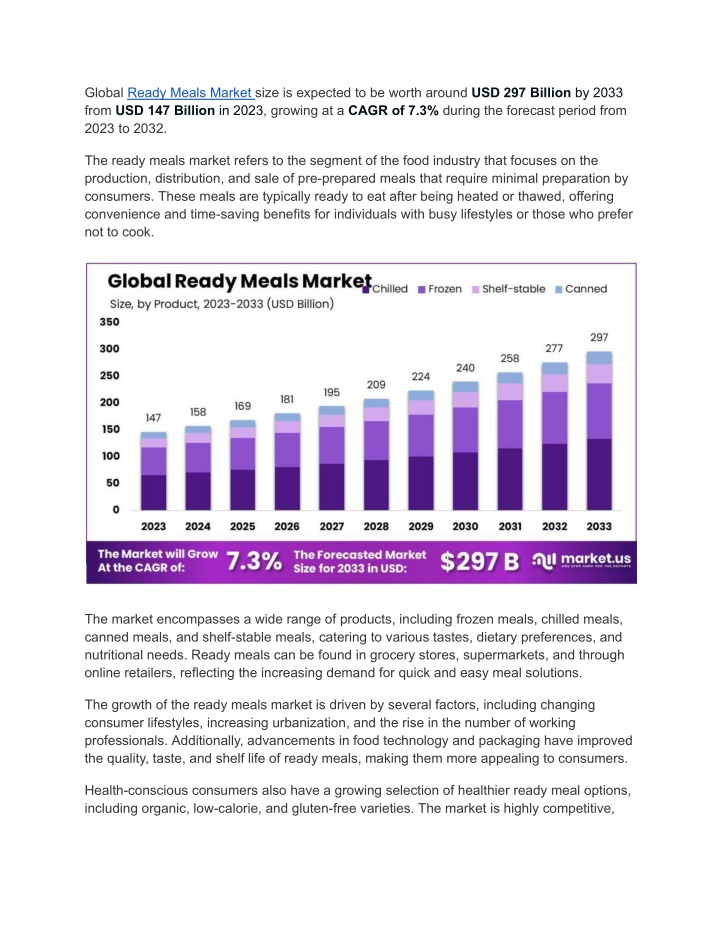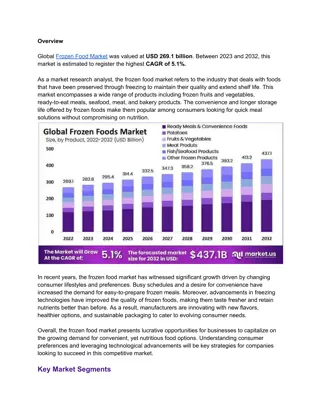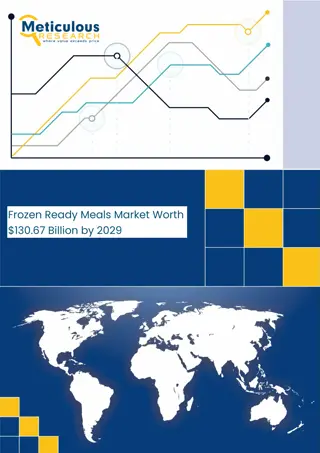
Ready Meals Market : The Ultimate Time-Saving Solution
Global Ready Meals Market size is expected to be worth around USD 297 Billion by 2033 from USD 147 Billion in 2023, growing at a CAGR of 7.3%
Download Presentation

Please find below an Image/Link to download the presentation.
The content on the website is provided AS IS for your information and personal use only. It may not be sold, licensed, or shared on other websites without obtaining consent from the author. If you encounter any issues during the download, it is possible that the publisher has removed the file from their server.
You are allowed to download the files provided on this website for personal or commercial use, subject to the condition that they are used lawfully. All files are the property of their respective owners.
The content on the website is provided AS IS for your information and personal use only. It may not be sold, licensed, or shared on other websites without obtaining consent from the author.
E N D
Presentation Transcript
Global Ready Meals Market size is expected to be worth around USD 297 Billion by 2033 from USD 147 Billion in 2023, growing at a CAGR of 7.3% during the forecast period from 2023 to 2032. The ready meals market refers to the segment of the food industry that focuses on the production, distribution, and sale of pre-prepared meals that require minimal preparation by consumers. These meals are typically ready to eat after being heated or thawed, offering convenience and time-saving benefits for individuals with busy lifestyles or those who prefer not to cook. The market encompasses a wide range of products, including frozen meals, chilled meals, canned meals, and shelf-stable meals, catering to various tastes, dietary preferences, and nutritional needs. Ready meals can be found in grocery stores, supermarkets, and through online retailers, reflecting the increasing demand for quick and easy meal solutions. The growth of the ready meals market is driven by several factors, including changing consumer lifestyles, increasing urbanization, and the rise in the number of working professionals. Additionally, advancements in food technology and packaging have improved the quality, taste, and shelf life of ready meals, making them more appealing to consumers. Health-conscious consumers also have a growing selection of healthier ready meal options, including organic, low-calorie, and gluten-free varieties. The market is highly competitive,
with both established food manufacturers and new entrants continuously innovating to capture market share and meet evolving consumer preferences. Key Market Segments By Product Chilled Frozen Shelf-stable Canned By Meal Type Vegan Vegetarian Non-vegetarian By Age Group 18-24 Years 25-34 Years 35-44 Years 45-54 Years Above 55 Years By End-use Residential Food Services By Distribution Channel Convenience Stores Supermarkets & Hypermarkets Online Others
Download a sample report in MINUTES@https://market.us/report/ready-meals-market/ In 2023, chilled ready meals led the market with a 45.6% share, driven by their freshness and minimal processing, appealing to consumers seeking convenient and nutritious options with a shorter shelf life. Vegan ready meals held a 40.3% share, driven by growing interest in plant-based diets for health and environmental reasons, appealing to those seeking cruelty-free and sustainable food options. The 18-24 years age group dominated the ready meals market, securing a 45.3% share, as young adults and college students prioritize convenience and quick meal solutions due to busy lifestyles and limited cooking skills. Food services emerged as the dominant segment, capturing a 65.4% share, including restaurants, cafeterias, catering services, and other food service providers catering to a wide range of consumers. Supermarkets and hypermarkets dominated the retail segment of the ready meals market with a 46.7% share, offering a wide variety of ready meals and catering to diverse consumer preferences due to their convenient locations, extensive product range, and one-stop shopping experience. Market Key Players Nestl General Mills, Inc. Kellogg Company 2 Sisters Food Group Conagra Brands Inc. Dr. Oetker Green Mill Foods Hormel Foods Corporation Iceland Foods Ltd McCain Foods Limited Nomad Foods The Campbell Soup The JM Smucker Co. The Kraft Heinz Tyson Foods Inc
Tyson Foods, Inc. Unilever Driver: The primary driver for the ready meals market is the shift in consumer lifestyles towards more hectic and busy schedules, increasing the demand for convenient and time-saving meal options. Additionally, rising disposable incomes globally contribute to the growing popularity of ready meals, as consumers are more willing to spend on convenience. Restraint: Fresh foods are considered superior alternatives to ready meals, and the rising popularity of fresh foods due to health consciousness and lifestyle disorder concerns serves as a significant restraint. The preference for fresh over packaged ready meals has been accelerated by recent developments during the COVID-19 pandemic. Opportunity: The increasing popularity of ready meals, coupled with rising disposable incomes, presents lucrative growth opportunities for the market over the forecast period. Manufacturers can capitalize on this trend by introducing a variety of ready meal options that cater to diverse consumer preferences and dietary needs. Challenge: The main challenge for the ready meals market is balancing convenience with health and nutritional value. As consumers become more health-conscious, ready meal producers must innovate to offer healthier options that compete with the perceived benefits of fresh foods. Ensuring high-quality, nutritious, and appealing ready meals is crucial to overcoming this challenge.






















